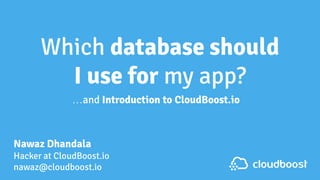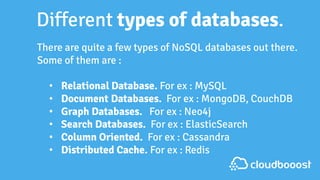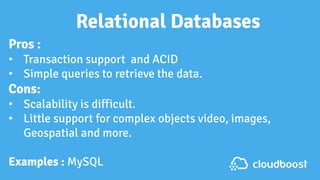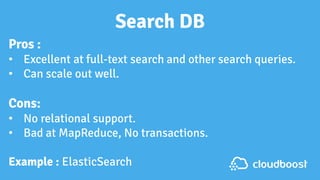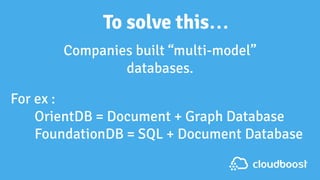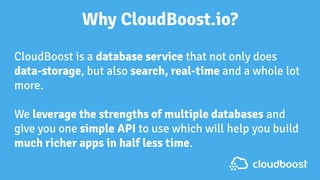Which database should I use for my app?
- 1. Nawaz Dhandala Hacker at CloudBoost.io nawaz@cloudboost.io Which database should I use for my app? ŌĆ”and Introduction to CloudBoost.io cloudboost
- 2. Agenda cloudboost ŌĆó Different types of databases ŌĆó Which database is right for my app?. ŌĆó Why use CloudBoost.io? ŌĆó Getting started with CloudBoost. ŌĆó Building your first web app. ŌĆó Using Data-storage, and real-time.
- 3. Different types of databases. There are quite a few types of NoSQL databases out there. Some of them are : ŌĆó Relational Database. For ex : MySQL ŌĆó Document Databases. For ex : MongoDB, CouchDB ŌĆó Graph Databases. For ex : Neo4j ŌĆó Search Databases. For ex : ElasticSearch ŌĆó Column Oriented. For ex : Cassandra ŌĆó Distributed Cache. For ex : Redis cloudbooost
- 4. Relational Databases Pros : ŌĆó Transaction support and ACID ŌĆó Simple queries to retrieve the data. Cons: ŌĆó Scalability is difficult. ŌĆó Little support for complex objects video, images, Geospatial and more. Examples : MySQL cloudboost
- 5. Document Databases Pros : ŌĆó Simple JSON Document Storage ŌĆó Extremely scalable ŌĆō Can scale out very well. Cons: ŌĆó No relations or joins. ŌĆó Most of the databases have no transaction support. Examples : MongoDB, CouchDB cloudboost
- 6. Graph Databases Pros : ŌĆó Excellent at storing relations between data. ŌĆó Relational queries / joins are extremely fast. Cons: ŌĆó Most of the graph databases are very hard to scale out. ŌĆó Can be conceptually difficult to understand at first. Example : Neo4j cloudboost
- 7. Search DB Pros : ŌĆó Excellent at full-text search and other search queries. ŌĆó Can scale out well. Cons: ŌĆó No relational support. ŌĆó Bad at MapReduce, No transactions. Example : ElasticSearch cloudboost
- 8. Column-oriented Pros : ŌĆó Fastest writes. Good for storing log / sensor data. ŌĆó Excellent scalability and high availability. Cons: ŌĆó No relational support. ŌĆó No transactions. Example : Cassandra cloudboost
- 9. Cache Pros : ŌĆó Fastest read / writes. Good for storing data you need all the time. ŌĆó Scalable and can be distributed over multiple machines Cons: ŌĆó Not persistent. ŌĆó It stores data on RAM which is expensive. Example : Redis cloudboost
- 10. Problem? No database available today can do everything which you need for your app.
- 11. To solve thisŌĆ” Companies built ŌĆ£multi-modelŌĆØ databases. For ex : OrientDB = Document + Graph Database FoundationDB = SQL + Document Database cloudboost
- 12. Problems with Multi-Model databases? They have two / three data-model supported which still does-not cover all the scenarios for the requirements of an app.
- 13. Solution? Pick and use multiple databases to build one app.
- 14. ŌĆ”and this is called ŌĆ£Polyglot PersistenceŌĆØ
- 15. For example, If youŌĆÖre building an e-commerce applicationŌĆ”
- 17. My App Document Database Search Database Logs Graphs for relations Which looks likeŌĆ”
- 18. Using multiple databases to build one app is an excellent solution butŌĆ”
- 19. As a developer you need toŌĆ” Hire an expert for each database. Learn different databases yourself. Sync data between databases Manage different databases yourself
- 20. Which meansŌĆ” Longer go-to-market time More Development and maintenance costs cloudboost
- 21. Why CloudBoost.io? CloudBoost is a database service that not only does data-storage, but also search, real-time and a whole lot more. We leverage the strengths of multiple databases and give you one simple API to use which will help you build much richer apps in half less time. cloudboost
- 24. A very simple API that doesŌĆ” Search Storage Relations Time Series Real-time Geo Location
- 25. For Developers We Auto Sync your Data We manage Databases A ton of features Save Time Simple API
- 27. Step 1 : Create your app cloudboost
- 28. Step 2 : Create a new table Create a new table with name ŌĆ£CustomŌĆØ cloudboost
- 29. Step 3 : Create a new column Create a new column ŌĆ£nameŌĆØ of type ŌĆ£textŌĆØ cloudboost
- 30. Step 4 : Get your App Keys cloudboost
- 31. Step 5 : Link the JS SDK
- 32. Step 6 : Init your app. cloudboost
- 33. Step 7 : Save Data ŌĆ£CustomŌĆØ is the name of the Table.
- 34. Step 8 : Adding real-time You can listen to any real-time notification event from the database service. Here for example, the event fires whenever a custom table object is inserted into the database. cloudboost
- 35. ThatŌĆÖs it folks! Build your next big thing on CloudBoost.io. #BeginToday For more features, visit ŌĆō http://docs.cloudboost.io

